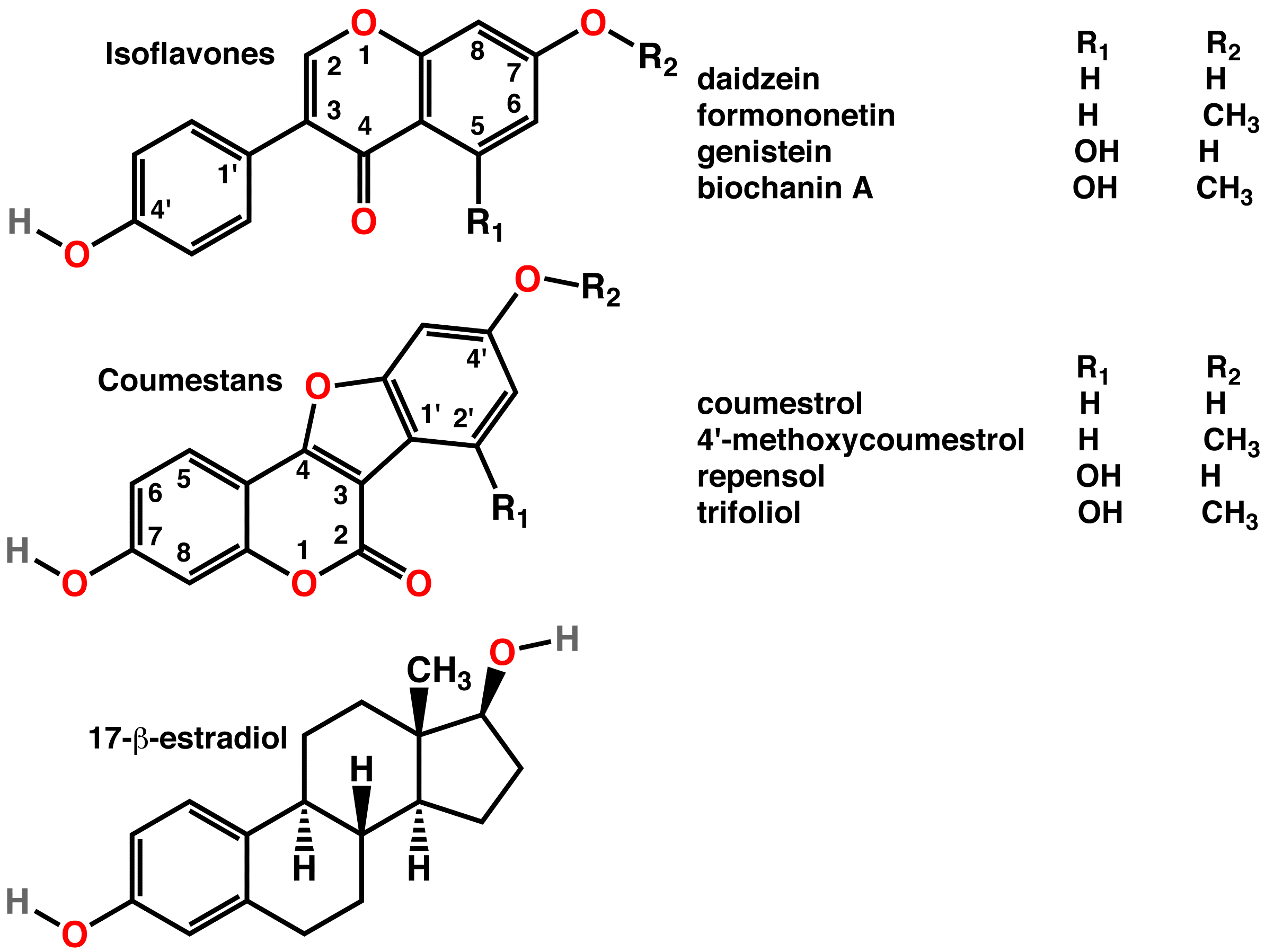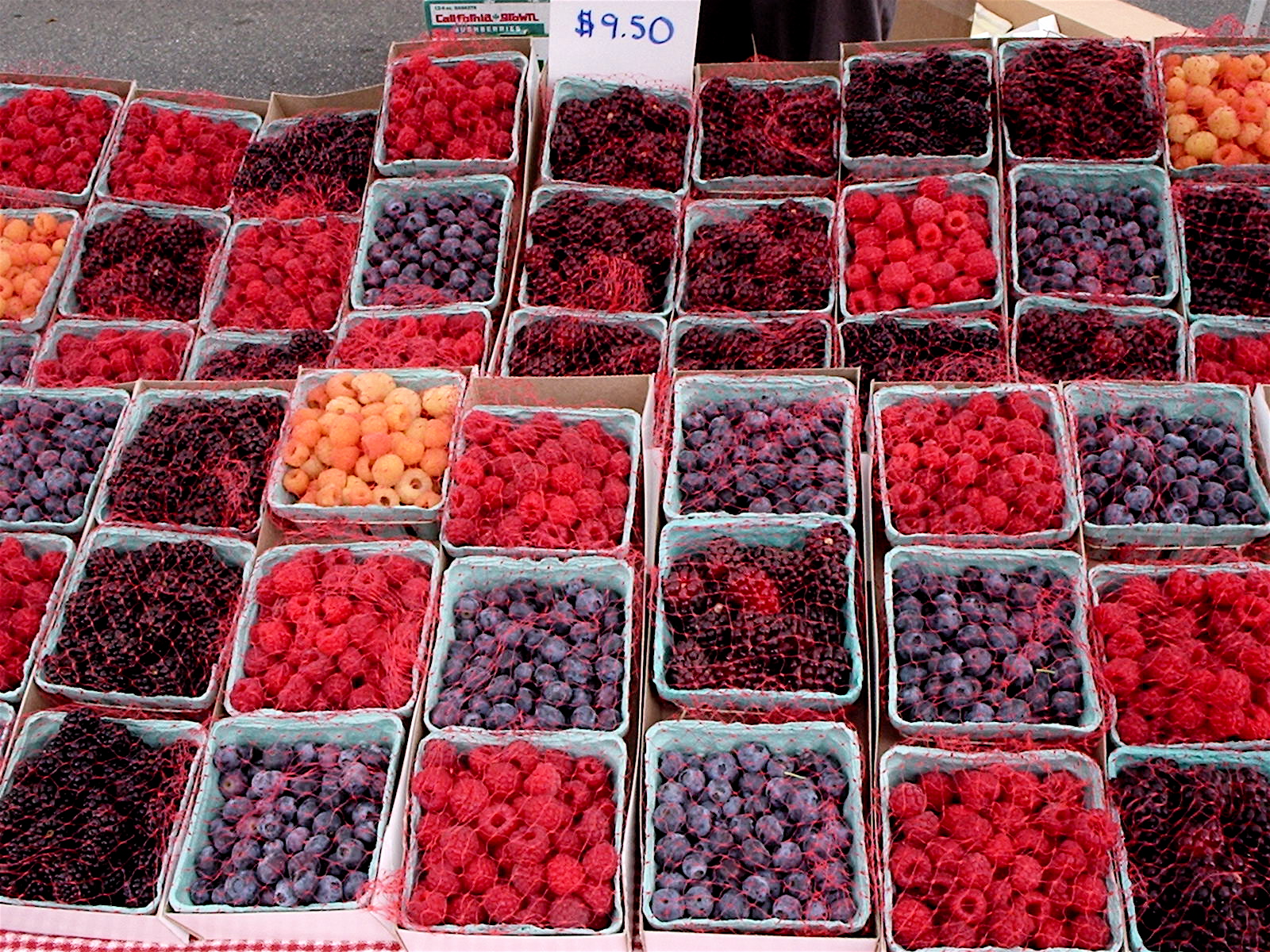|
Biochanin A
Biochanin A is an O-methylated isoflavone, ''O''-methylated isoflavone. It is a natural organic compound in the class of phytochemicals known as flavonoids. Biochanin A can be found in red clover in soy, in alfalfa sprouts, in peanuts, in chickpea (''Cicer arietinum'') and in other legumes. Biochanin A is classified as a phytoestrogen and has putative benefits in dietary List of oncology-related terms, cancer prophylaxis. It has also been found to be a weak enzyme inhibitor, inhibitor of fatty acid amide hydrolase ''in vitro''. Metabolism The enzyme biochanin-A reductase uses dihydrobiochanin A and NADP+ to produce biochanin A, NADPH, and H+. The enzyme isoflavone-7-O-beta-glucoside 6"-O-malonyltransferase uses malonyl-CoA and biochanin A 7-O-β-D-glucoside to produce CoA and biochanin A 7-O-(6-O-malonyl-β-D-glucoside). See also * List of phytochemicals in food * Prunetin References {{Estrogen-related receptor modulators Aromatase inhibitors O-methylated isoflavones ... [...More Info...] [...Related Items...] OR: [Wikipedia] [Google] [Baidu] |
O-methylated Isoflavone
The O-methylated flavonoids or methoxyflavonoids are flavonoids with methylations on hydroxyl groups (methoxy bonds). O-methylation has an effect on the solubility of flavonoids. Enzymes O-methylated flavonoids formation implies the presence of specific O-methyltransferase (OMT) enzymes which accept a variety of substrates. Those enzymes mediate the O-methylation on a specific hydroxyl group, like on 4' (example in ''Catharanthus roseus'') or 3' (example in rice) positions. Those positions can be Arene substitution patterns, ortho, meta, para and there can be a special 3-O-methyltransferase for the 3-OH position. Calamondin orange (''Citrus mitis'') exhibits all of those activities. Plant enzymes * Apigenin 4'-O-methyltransferase * 8-hydroxyquercetin 8-O-methyltransferase * Isoflavone 4'-O-methyltransferase * Isoflavone 7-O-methyltransferase * Isoliquiritigenin 2'-O-methyltransferase * Isoorientin 3'-O-methyltransferase * Kaempferol 4'-O-methyltransferase * Luteolin O-methyltransfer ... [...More Info...] [...Related Items...] OR: [Wikipedia] [Google] [Baidu] |
In Vitro
''In vitro'' (meaning ''in glass'', or ''in the glass'') Research, studies are performed with Cell (biology), cells or biological molecules outside their normal biological context. Colloquially called "test-tube experiments", these studies in biology and its subdisciplines are traditionally done in labware such as test tubes, flasks, Petri dishes, and microtiter plates. Studies conducted using components of an organism that have been isolated from their usual biological surroundings permit a more detailed or more convenient analysis than can be done with whole organisms; however, results obtained from ''in vitro'' experiments may not fully or accurately predict the effects on a whole organism. In contrast to ''in vitro'' experiments, ''in vivo'' studies are those conducted in living organisms, including humans, known as clinical trials, and whole plants. Definition ''In vitro'' (Latin language, Latin for "in glass"; often not italicized in English usage) studies are conducted ... [...More Info...] [...Related Items...] OR: [Wikipedia] [Google] [Baidu] |
Phytoestrogens
A phytoestrogen is a plant-derived xenoestrogen (a type of estrogen produced by organisms other than humans) not generated within the endocrine system, but consumed by eating plants or manufactured foods. Also called a "dietary estrogen", it is a diverse group of naturally occurring nonsteroidal plant compounds that, because of its structural similarity to estradiol (17-β-estradiol), have the ability to cause both estrogenic or antiestrogenic effects. Phytoestrogens are not essential nutrients because their absence from the diet does not cause a disease, nor are they known to participate in any normal biological function. Common foods containing phytoestrogens are soybeans and soy protein concentrate, miso, tempeh, and tofu. Some soy-based infant formulas manufactured with soy protein contain isoflavones. Its name comes from the Greek language, Greek ''phyto'' ("plant") and ''estrogen'', the hormone which gives fertility to female mammals. The word "estrus" (Greek οίστ� ... [...More Info...] [...Related Items...] OR: [Wikipedia] [Google] [Baidu] |
Aromatase Inhibitors
Aromatase inhibitors (AIs) are a class of medication, drugs used in the treatment of breast cancer in menopause, postmenopausal women and in men, and gynecomastia in men. They may also be used off-label to reduce estrogen conversion when supplementing testosterone exogenously. They may also be used for chemoprevention in women at high risk for breast cancer. Aromatase is the enzyme that catalyzes a key aromatization step in the synthesis of estrogen. It converts the Alpha-beta Unsaturated carbonyl compounds, enone ring of androgen precursors such as testosterone, to a phenol, completing the synthesis of estrogen. As such, AIs are estrogen synthesis inhibitors. Because hormone-positive breast and ovarian cancers are dependent on estrogen for growth, AIs are taken to either block the production of estrogen or block the action of estrogen on receptors. Medical uses Cancer In contrast to premenopausal women, in whom most of the estrogen is produced in the ovary, ovaries, in postmeno ... [...More Info...] [...Related Items...] OR: [Wikipedia] [Google] [Baidu] |
Prunetin
Prunetin is an O-methylated isoflavone, a type of flavonoid. It has been isolated for the first time by Finnemore in 1910 in the bark of ''Prunus emarginata'' (the Oregon cherry). Prunetin isolated from pea roots can act as an attractant for '' Aphanomyces euteiches'' zoospores. It is also an allosteric inhibitor of human liver aldehyde dehydrogenase. Prunetin can lower blood pressure of spontaneously hypertensive rats and relax isolated rat aortic rings through calcium channel block mechanisms in vessel smooth muscles. Glycosides * 8-C-glucosyl prunetin, isolated from the leaves of '' Dalbergia hainanensis'' See also * List of phytochemicals in food * Biochanin A Biochanin A is an O-methylated isoflavone, ''O''-methylated isoflavone. It is a natural organic compound in the class of phytochemicals known as flavonoids. Biochanin A can be found in red clover in soy, in alfalfa sprouts, in peanuts, in chickpea ... References {{isoflavone O-methylated isoflavones ... [...More Info...] [...Related Items...] OR: [Wikipedia] [Google] [Baidu] |
List Of Phytochemicals In Food
The following is a list of phytochemicals present in foods. Terpenoids (isoprenoids) Carotenoids ( tetraterpenoids) ''Carotenes'' orange pigments * α-Carotene – to vitamin A: carrots, pumpkins, maize, tangerine, orange * β-Carotene – to vitamin A: dark, leafy greens, red, orange and yellow fruits and vegetables. * γ-Carotene - to vitamin A * δ-Carotene * ε-carotene * Lycopene: Vietnamese Gac, tomatoes, grapefruit, watermelon, guava, apricots, carrots, autumn olive. * Neurosporene: tomato, pink grapefruit,watermelon * Phytofluene: star fruit, sweet potato, orange * Phytoene: sweet potato, orange '' Xanthophylls'' yellow pigments * Canthaxanthin: paprika, mushrooms, crustaceans, fish and eggs . * β-Cryptoxanthin to vitamin A: mango, tangerine, orange, papaya, peaches, avocado, pea, grapefruit, kiwi * Zeaxanthin: wolfberry, spinach, kale, turnip greens, maize, eggs, red pepper, pumpkin, orange * Astaxanthin: microalgae, yeast, ... [...More Info...] [...Related Items...] OR: [Wikipedia] [Google] [Baidu] |
Isoflavone-7-O-beta-glucoside 6"-O-malonyltransferase
In enzymology, an isoflavone-7-O-beta-glucoside 6"-O-malonyltransferase () is an enzyme that catalyzes the chemical reaction :malonyl-CoA + biochanin A 7-O-beta-D-glucoside \rightleftharpoons CoA + biochanin A 7-O-(6-O-malonyl-beta-D-glucoside) Thus, the two substrates of this enzyme are malonyl-CoA and biochanin A 7-O-beta-D-glucoside, whereas its two products are CoA and biochanin A 7-O-(6-O-malonyl-beta-D-glucoside). This enzyme belongs to the family of transferases, specifically those acyltransferases transferring groups other than aminoacyl groups. The systematic name of this enzyme class is malonyl-CoA:isoflavone-7-O-beta-D-glucoside 6"-O-malonyltransferase. Other names in common use include flavone/flavonol 7-O-beta-D-glucoside malonyltransferase, flavone (flavonol) 7-O-glycoside malonyltransferase, malonyl-CoA:flavone/flavonol 7-O-glucoside malonyltransferase, MAT-7, malonyl-coenzyme A:isoflavone 7-O-glucoside-6"-malonyltransferase, and malonyl-coenzyme A:flavone/flav ... [...More Info...] [...Related Items...] OR: [Wikipedia] [Google] [Baidu] |
Biochanin-A Reductase
In enzymology, a biochanin-A reductase () is an enzyme that catalyzes the chemical reaction :dihydrobiochanin A + NADP+ \rightleftharpoons biochanin A + NADPH + H+ Thus, the two substrates of this enzyme are dihydrobiochanin A and NADP+, whereas its 3 products are biochanin A, NADPH, and H+. This enzyme belongs to the family of oxidoreductases, specifically those acting on the CH-CH group of donor with NAD+ or NADP+ as acceptor. The systematic name A systematic name is a name given in a systematic way to one unique group, organism, object or chemical substance, out of a specific population or collection. Systematic names are usually part of a nomenclature. A semisystematic name or semitrivi ... of this enzyme class is dihydrobiochanin-A:NADP+ Delta2-oxidoreductase. This enzyme participates in isoflavonoid biosynthesis. References * EC 1.3.1 NADPH-dependent enzymes Enzymes of unknown structure Isoflavonoids metabolism {{1.3-enzyme-stub ... [...More Info...] [...Related Items...] OR: [Wikipedia] [Google] [Baidu] |
Fatty Acid Amide Hydrolase
Fatty-acid amide hydrolase 1 (FAAH) is a member of the serine hydrolase family of enzymes. It was first shown to break down anandamide (AEA), an ''N''-acylethanolamine (NAE) in 1993. In humans, it is encoded by the gene ''FAAH''.; Function FAAH is an integral membrane hydrolase with a single ''N''-terminal transmembrane domain. In vitro, FAAH has esterase and amidase activity. In vivo, FAAH is the principal catabolic enzyme for a class of bioactive lipids called the fatty acid amides (FAAs). Members of the FAAs include: * Anandamide (''N''-arachidonoylethanolamine), an endocannabinoid * 2-arachidonoylglycerol (2-AG), an endocannabinoid. * Other ''N''-acylethanolamines, such as ''N''-oleoylethanolamine and ''N''-palmitoylethanolamine * The sleep-inducing lipid oleamide * The ''N''-acyltaurines, which are agonists of the transient receptor potential (TRP) family of calcium channels. ''FAAH'' knockout mice display highly elevated (>15-fold) levels of ''N''-acylethanolamin ... [...More Info...] [...Related Items...] OR: [Wikipedia] [Google] [Baidu] |
Phytochemical
Phytochemicals are naturally-occurring chemicals present in or extracted from plants. Some phytochemicals are nutrients for the plant, while others are metabolites produced to enhance plant survivability and reproduction. The fields of extracting phytochemicals for manufactured products or applying scientific methods to study phytochemical properties are called ''phytochemistry''. An individual who uses phytochemicals in food chemistry manufacturing or research is a ''phytochemist''. Phytochemicals without a nutrient definition have no confirmed biological activities or proven health benefits when consumed in plant foods. Once phytochemicals in a food enter the digestion process, the fate of individual phytochemicals in the body is unknown due to extensive metabolism of the food in the gastrointestinal tract, producing phytochemical metabolites with different biological properties from those of the parent compound that may have been tested in vitro. Further, the bioavaila ... [...More Info...] [...Related Items...] OR: [Wikipedia] [Google] [Baidu] |
Enzyme Inhibitor
An enzyme inhibitor is a molecule that binds to an enzyme and blocks its Enzyme activity, activity. Enzymes are proteins that speed up chemical reactions necessary for life, in which Substrate (biochemistry), substrate molecules are converted into Product (chemistry), products. An enzyme Enzyme catalysis, facilitates a specific chemical reaction by binding the substrate to its active site, a specialized area on the enzyme that accelerates the Rate-determining step, most difficult step of the reaction. An enzyme inhibitor stops ("inhibits") this process, either by binding to the enzyme's active site (thus preventing the substrate itself from binding) or by binding to another site on the enzyme such that the enzyme's catalysis of the reaction is blocked. Enzyme inhibitors may bind Reversible reaction, reversibly or irreversibly. Irreversible inhibitors form a Covalent bond, chemical bond with the enzyme such that the enzyme is inhibited until the chemical bond is broken. By cont ... [...More Info...] [...Related Items...] OR: [Wikipedia] [Google] [Baidu] |


